1993 CHEVROLET CAVALIER tow
[x] Cancel search: towPage 87 of 308
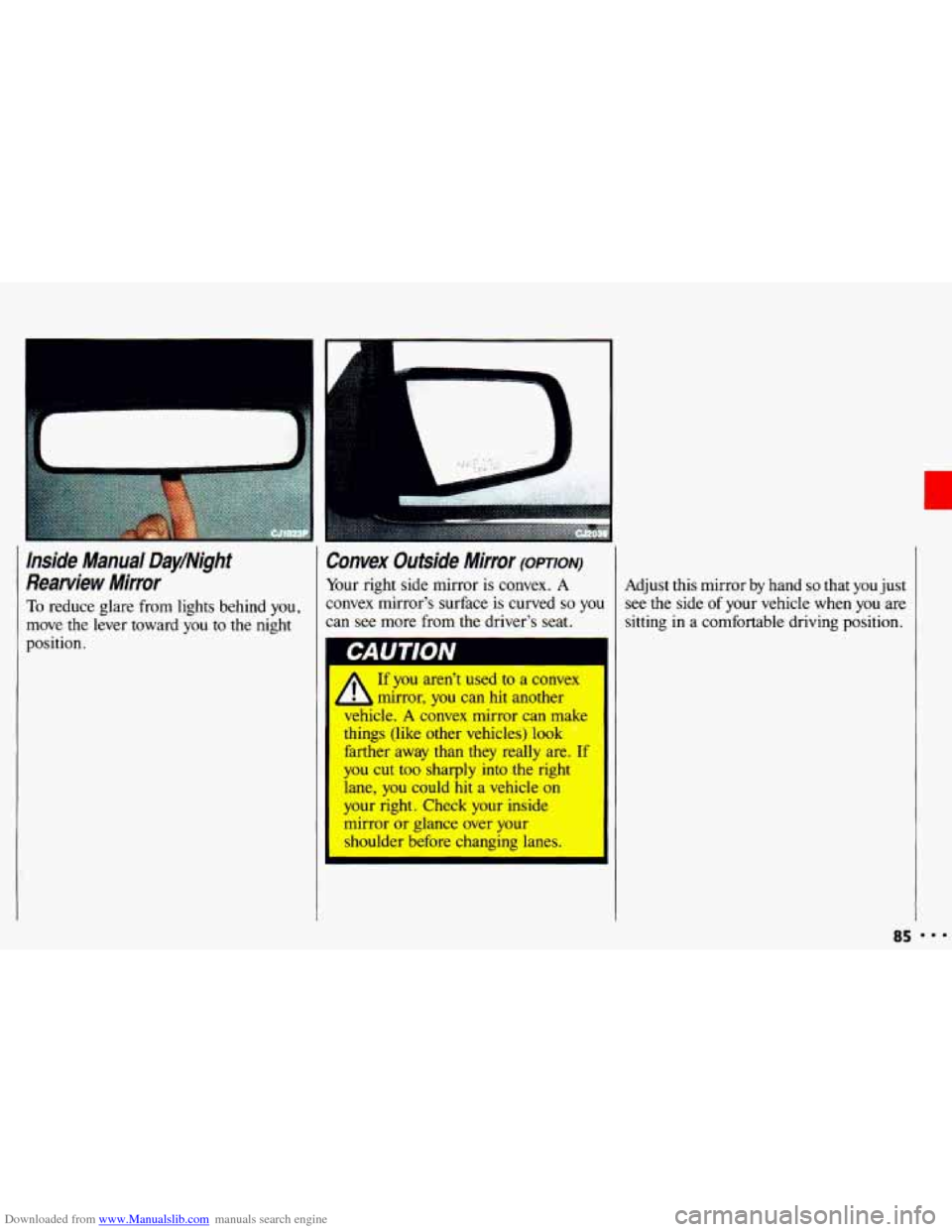
Downloaded from www.Manualslib.com manuals search engine Inside Manual DayINight
Rearview Mirror
To reduce glare from lights behind you,
move
the lever toward you to the night
position.
Convex Outsjde Mirror (OPTION)
Your right side mirror is convex. A
convex mirror’s surface is curved
so you
can see more from the driver’s seat.
I CAUTioN
I
If you aren’t used to a convex
mirror, you can hit another
vehicle.
A convex mirror can make
things (like other vehicles) look
farther away than they really are. If
you cut too sharply into the right
lane, you could
hit a vehicle on
your right. Check your inside
mirror or glance over your
shoulder before changing lanes. Adjust
this mirror
by hand so that you just
see the side
of your vehicle when you are
sitting
in a comfortable driving position.
85
Page 102 of 308
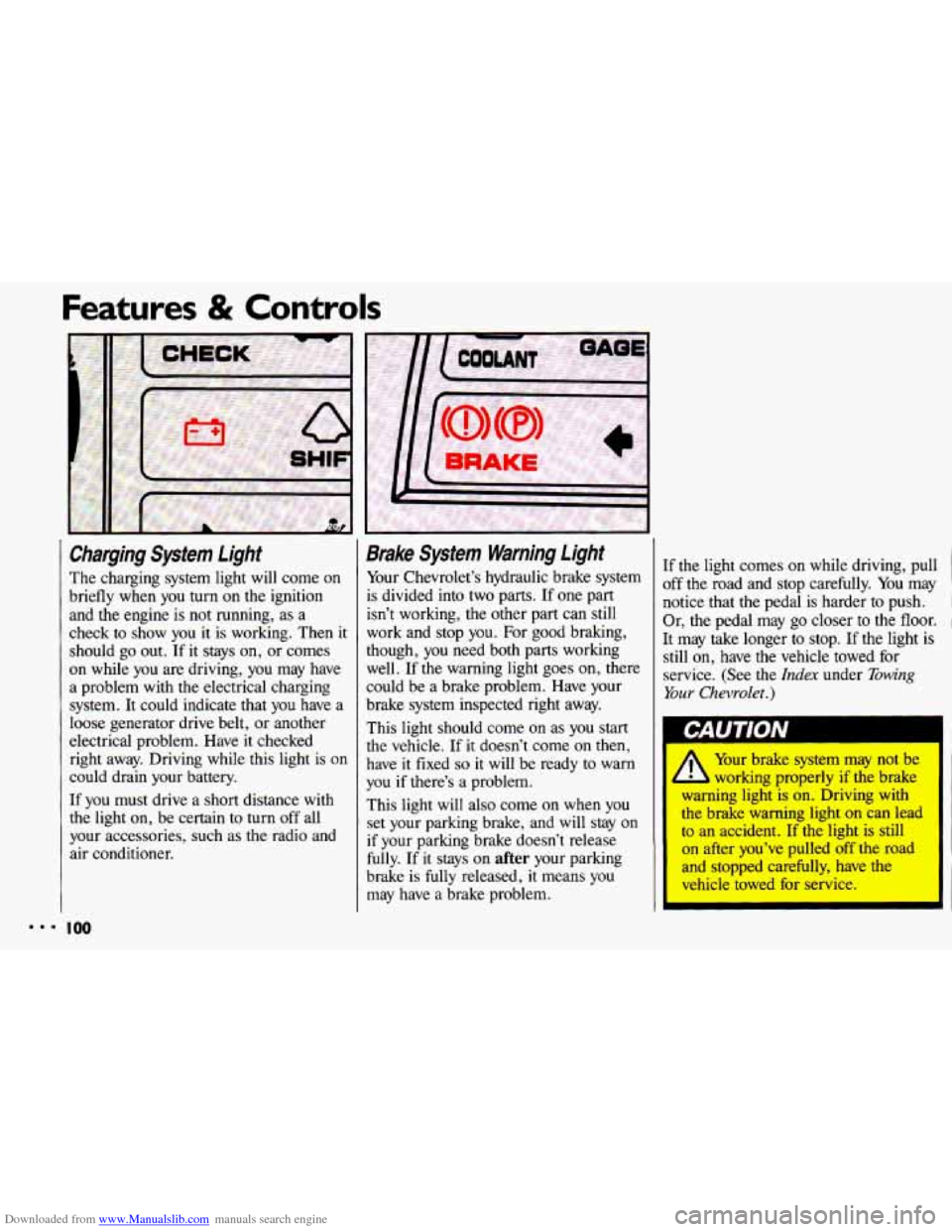
Downloaded from www.Manualslib.com manuals search engine Features & Controls
Charging System Light
The charging system light will come on
briefly when
you turn on the ignition
and the engine is not running, as a
check to show you it is working. Then it
should go out. If it stays on, or comes
on while you are driving, you may have
a problem with the electrical charging
system.
It could indicate that you have a
loose generator drive belt, or another
electrical problem. Have
it checked
right away. Driving while this light is on
could drain your battery.
If you must drive a short distance with
the light on, be certain to turn off all
your accessories, such as the radio and
air conditioner.
Brake Sysfem Warning Light
Your Chevrolet’s hydraulic brake system
is divided into two parts. If one part
isn’t working, the other part can still
work and stop you. For good braking,
though, you need both parts working
well. If the warning light goes on, there
could be a brake problem. Have your
brake system inspected right away.
This light should come on as you start
the vehicle. If it doesn’t come on then,
have
it fixed so it will be ready to warn
you if there’s
a problem.
This light will also come on when you
set your parking brake, and will stay
on
if your parking brake doesn’t release
fully. If it stays
on after your parking
brake is fully released,
it means you
may have
a brake problem. If
the light comes
on while driving, pull
off the road and stop carefully. You may
notice that the pedal is harder to push.
I
Or, the pedal may go closer to the floor. 1
It may take longer to stop. If the light is
still on, have the vehicle towed for
service. (See the
Index under Towing
Your Chevrolet.)
L-AU I IVN
I
/1 Your brake system may not be
L working properly if the brake
warning light is on. Driving with
the brake warning light
on can lead
to an accident. If the light is still
on after you’ve pulled off the road
and stopped carefully, have the
vehicle towed for service.
I
Page 111 of 308
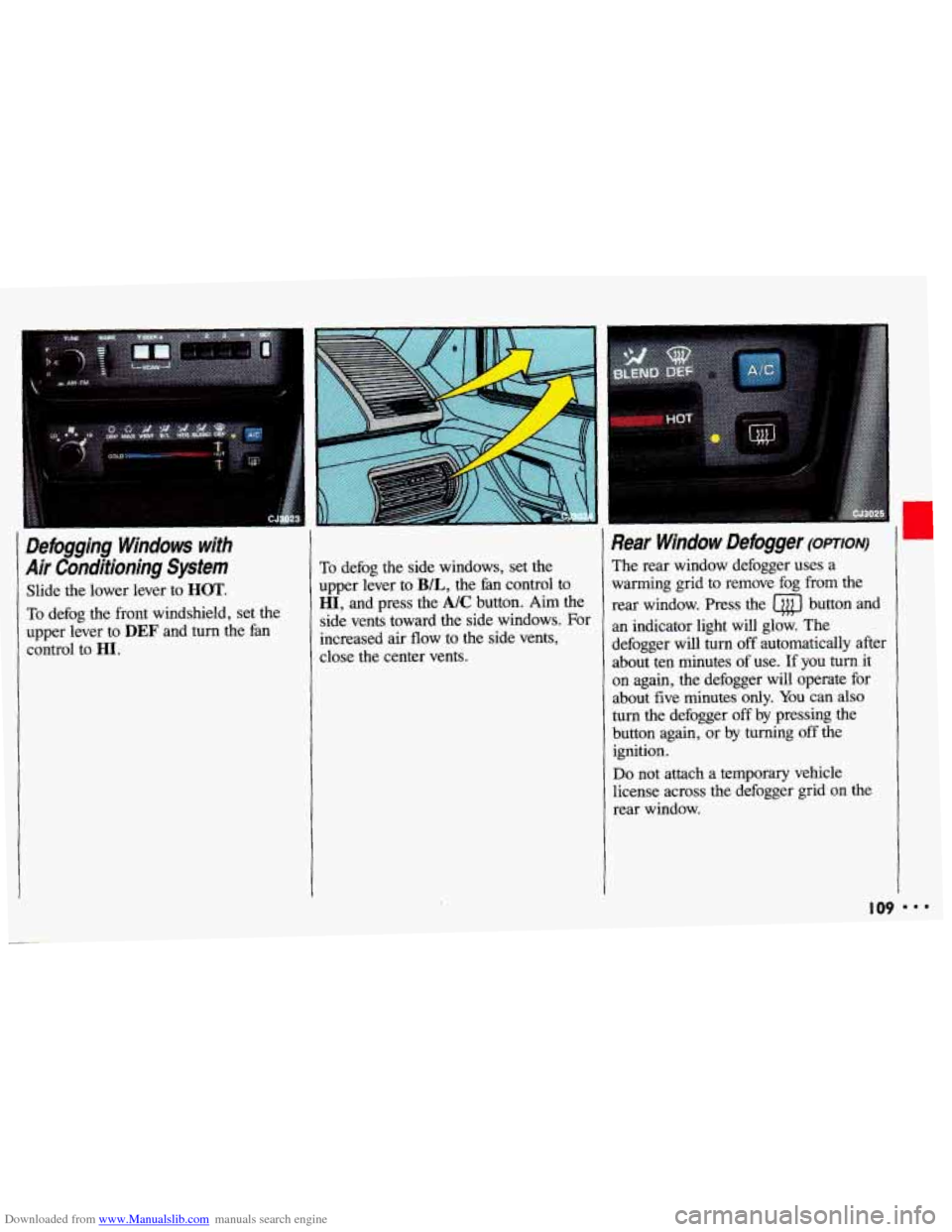
Downloaded from www.Manualslib.com manuals search engine i; . ... ..- -. . ,' $,
Defogging Windows with
Air Conditioning System
Slide the lower lever to HOT.
To defog the front windshield, set the
upper lever to
DEF and turn the fan
control to HI.
To defog the side windows, set the
upper lever to
B/L, the fan control to
HI, and press the A/C button. Aim the
side vents toward the side windows. For
increased air flow to the side vents,
close the center vents.
Rear Window Defogger (omoN)
The rear window defogger uses a
warming grid to remove fog from the
rear window. Press the
a button and
an indicator light will glow. The
defogger will turn
off automatically after
about ten minutes of use. If you
turn it
on again, the defogger will operate for
about five minutes
only. You can also
turn the defogger off by pressing the
button again, or by turning off the
ignition.
Do not attach a temporary vehicle
license across the defogger grid on
the
rear window.
I09 I..
Page 125 of 308
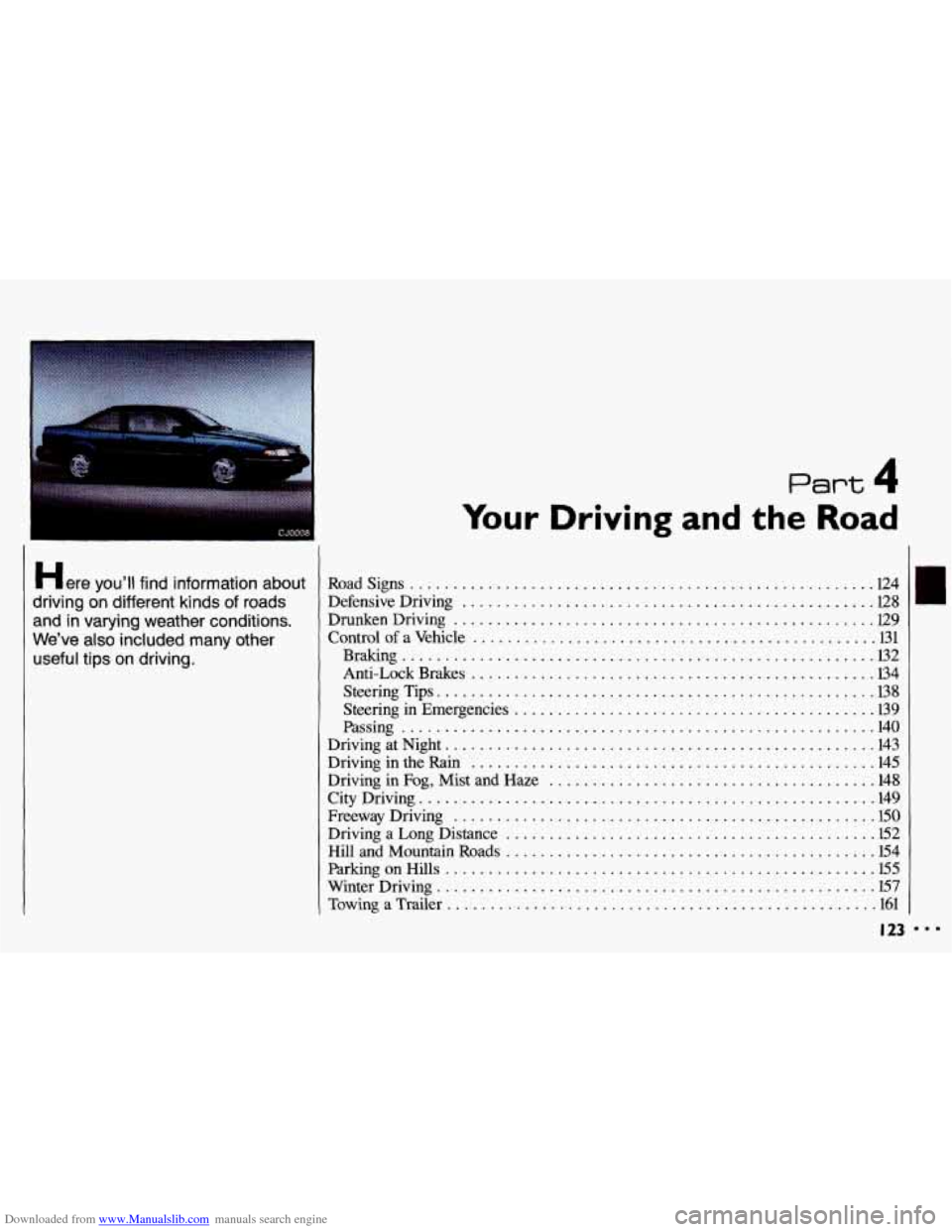
Downloaded from www.Manualslib.com manuals search engine Part 4
Here you’ll find information about
driving on different kinds of roads
and in varying weather conditions
.
We’ve also included many other
useful tips on driving
.
Your Driving and the Road
Roadsigns ...................................................... 124
Defensive Driving ................................................ 128
Drunken Driving ................................................. 129
Control of a Vehicle ............................................... 131
Braking ....................................................... 132
Anti-Lock Brakes ............................................... 134
Steering Tips ................................................... 138
Steering in Emergencies .......................................... 139
Passing ....................................................... 140
DrivingatNight
.................................................. 143
Driving in the Rain ............................................... 145
Driving in Fog, Mist and Haze ...................................... 148
CityDriving ...................................................... 149
Freeway Driving ................................................. 150
Driving a Long Distance ........................................... 152
HillandMountainRoads ........................................... 154
ParkingonHills .................................................. 155
Winter Driving ................................................... 157
TowingaTrailer .................................................. 161
I23
Page 130 of 308
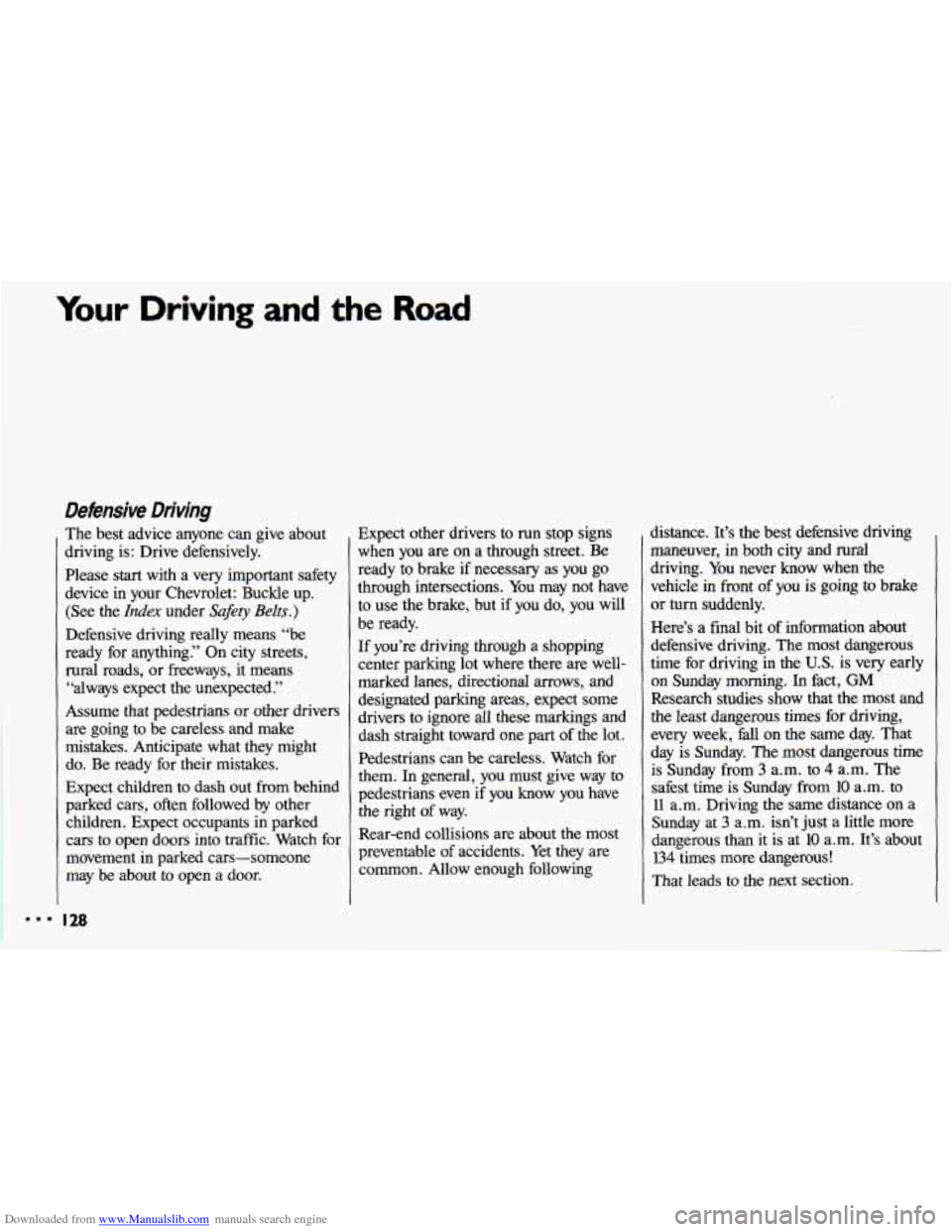
Downloaded from www.Manualslib.com manuals search engine Your Driving and the Road
Defensive Driving
The best advice anyone can give about
driving is: Drive defensively.
Please
start with a very important safety
device in your Chevrolet: Buckle up. (See the
Index under Safety Belts.)
Defensive driving really means “be
ready for anything.” On city streets, rural roads, or freeways, it means
“always expect the unexpected.”
Assume that pedestrians or other drivers
are going to be careless and make
mistakes. Anticipate what they might do. Be ready for their mistakes.
Expect children to dash out from behind
parked cars, often followed by other
children. Expect occupants in parked
cars to open doors into traffic. Watch for movement in parked cars-someone
may be about to open a door.
213
Expect other drivers to run stop signs
when you are on a through street. Be
ready to brake if necessary as you go
through intersections. You may not have
to use the brake, but if you do, you will
be ready.
If you’re driving through a shopping
center parking lot where there are well-
marked lanes, directional arrows, and
designated parking areas, expect some
drivers to ignore
all these markings and
dash straight toward one part of the lot.
Pedestrians can be careless. Watch for
them.
In general, you must give way to
pedestrians even if you know you have
the right of way.
Rear-end collisions are about the most
preventable of accidents. Yet they are
common. Allow enough following distance. It’s the best defensive driving
maneuver, in both city and
rural
driving.
You never know when the
vehicle in front of you is going
to brake
or turn suddenly.
Here’s a final bit
of information about
defensive driving. The most dangerous
time for driving in the
U.S. is very early
on Sunday morning.
In fact, GM
Research studies show that the most and
the least dangerous times for driving,
every week, fall on the same day. That
day is Sunday. The most dangerous time
is Sunday from
3 a.m. to 4 a.m. The
safest time is Sunday from
10 a.m. to
11 a.m. Driving the same distance on a
Sunday at
3 a.m. isn’t just a little more
dangerous than it is at
10 a.m. It’s about
134 times more dangerous!
That leads to the next section.
Page 153 of 308
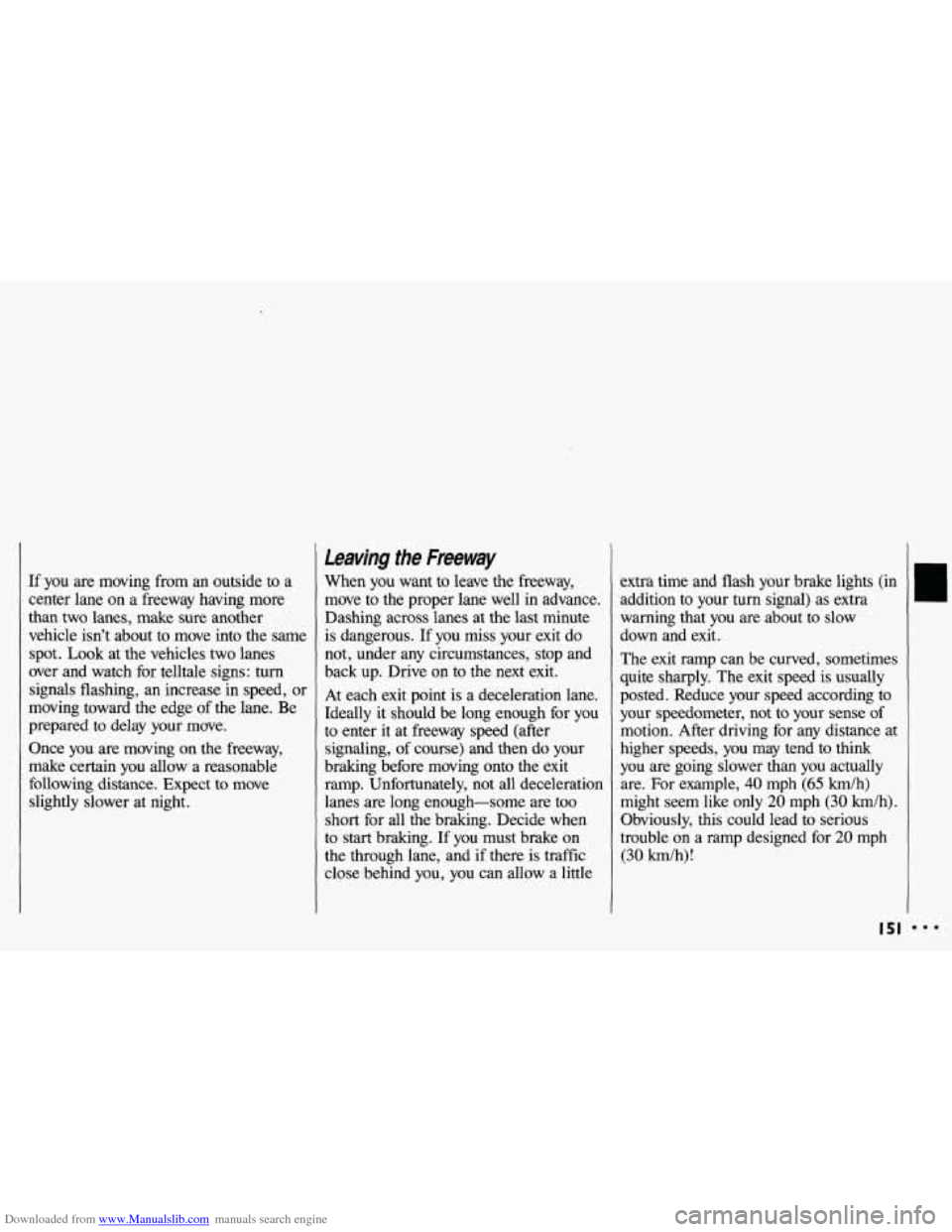
Downloaded from www.Manualslib.com manuals search engine If you are moving from an outside to a
center lane on a freeway having more
than two lanes, make sure another vehicle isn’t about to move into the same
spot. Look at the vehicles two lanes
over and watch for telltale signs: turn
signals flashing, an increase in speed, or
moving toward the edge of the lane. Be
prepared
to delay your move.
Once you are moving on the freeway,
make certain you allow a reasonable
following distance. Expect to move
slightly slower at night.
Leaving the Freeway
When you want to leave the freeway,
move to the proper lane well in advance.
Dashing across lanes at the last minute
is dangerous. If you
miss your exit do
not, under any circumstances, stop and
back up. Drive on to the next exit.
At each exit point is
a deceleration lane.
Ideally it should be long enough for you
to enter it at freeway speed (after
signaling, of course) and then do your
braking before moving onto the exit
ramp. Unfortunately, not all deceleration
lanes
are long enough-some are too
short for all the braking. Decide when
to start braking. If you must brake on
the through lane, and if there is traffic
close behind you, you can allow a little extra
time and flash your brake lights (in
addition to your turn signal) as extra
warning that you are about to slow
down and exit.
The exit ramp can be curved, sometimes
quite sharply. The exit speed is usually
posted. Reduce your speed according to
your speedometer, not to your sense
of
motion. After driving for any distance at
higher speeds, you may tend to think
you are going slower than you actually
are. For example,
40 mph (65 km/h)
might seem like only
20 mph (30 km/h).
Obviously, this could lead to serious
trouble on a ramp designed for
20 mph
(30 km/h)!
I51
Page 156 of 308
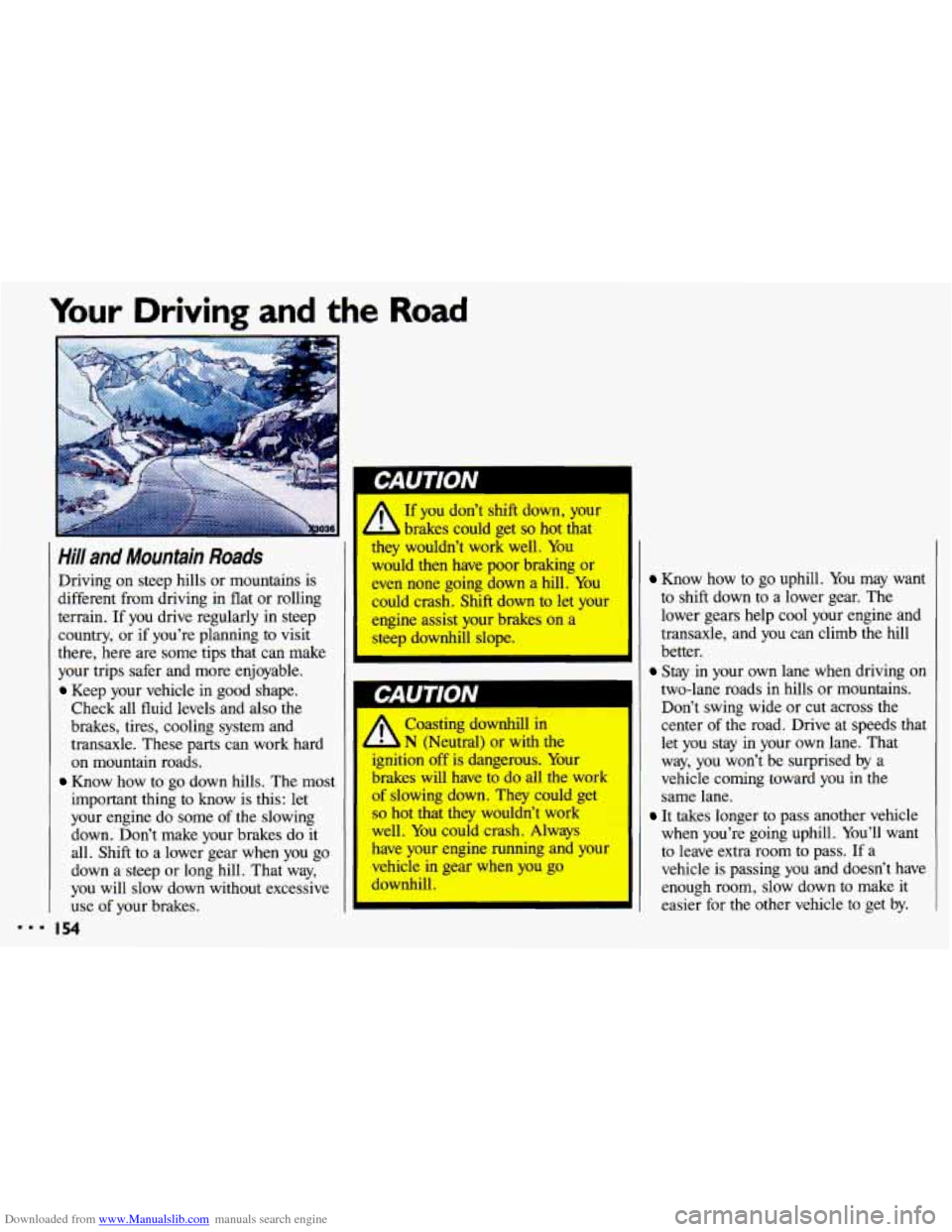
Downloaded from www.Manualslib.com manuals search engine Your Driving and the Road
mmm ‘I
”- .
Hill and Mountain Roads
Driving on steep hills or mountains is
different from driving in flat or rolling
terrain. If you drive regularly in steep
country, or if you’re planning to visit
there, here are some tips that can make
your trips safer and more enjoyable.
Keep your vehicle in good shape.
Check all fluid levels and
also the
brakes, tires, cooling system and
transaxle. These parts can work hard
on mountain roads.
Know how to go down hills. The most
important thing to know is this: let
your engine do some
of the slowing
down. Don’t make your brakes do it
all. Shift to a lower gear when you go
down a steep or long hill. That way,
you will slow down without excessive use of your brakes.
I 54
r If you don’t shift down, your
brakes could get
so hot that
they wouldn’t work well. You
would then have poor braking or
even none going down a hill. You
could crash. Shift down to let your
engine assist your brakes on a
steep downhill slope.
Coasting downhill in
N (Neutral) or with the
ignition
off is dangerous. Your
brakes will have
to do all the work
of slowing down. They could get
so hot that they wouldn’t work
well.
You could crash. Always
have
your engine running and your
vehicle in gear when you go
downhill.
Know how to go uphill. You may want
to shift down to a lower gear. The
lower gears help cool your engine and
transaxle, and
you can climb the hill
better.
Stay in your own lane when driving on
two-lane roads in hills or mountains.
Don’t swing wide or cut across the
center of the road. Drive at speeds that
let you stay in your own lane. That
way, you won’t be surprised by a
vehicle coming toward you in the
same lane.
It takes longer to pass another vehicle
when you’re going uphill. You’ll want
to leave extra room to pass.
If a
vehicle is passing you and doesn’t have
enough room, slow down to make it
~ easier for the other vehicle to get by.
Page 163 of 308
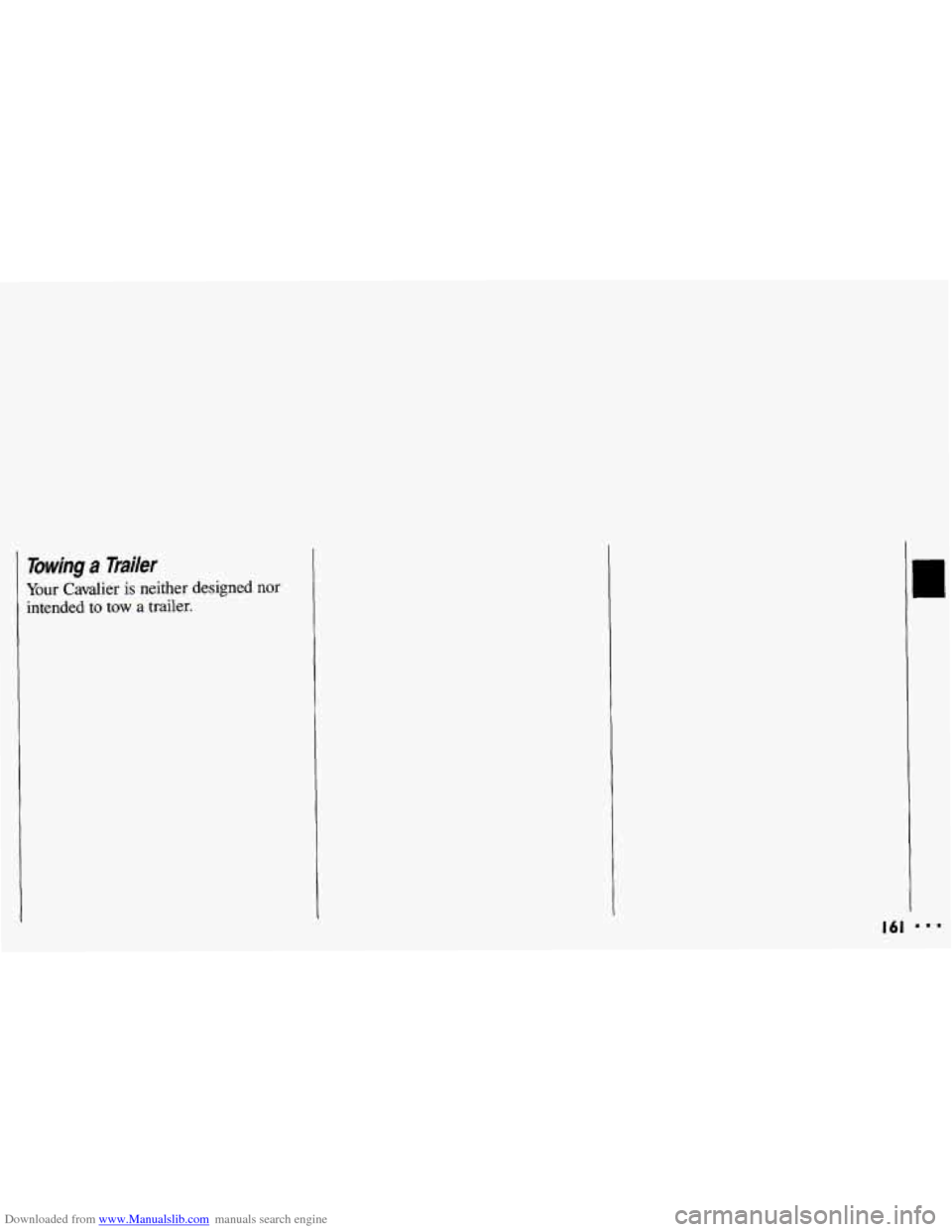
Downloaded from www.Manualslib.com manuals search engine Towing a nailer
Your Cavalier is neither designed nor
intended to tow a trailer.